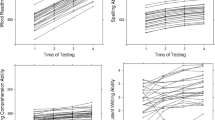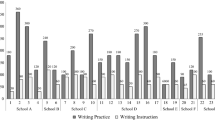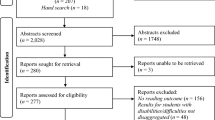Abstract
The present study examined the relationship between reading (i.e., rapidity and accuracy) and writing competences (i.e., fluency, accuracy, and composition skills) of Italian children in the first and second grade. The performance of seventy-five children was longitudinally assessed over a 2-year period. Results demonstrated that reading and spelling were stable across the first two grades of primary school. Cross-lagged analyses suggested that spelling plays a pivotal role in the acquisition of formal literacy, especially within a transparent writing system like that of our Italian participants. Early progress in spelling becomes a resource for later reading acquisition. However, spelling did not correlate with the composition component of writing, suggesting the independence of these two processes. Results have implications for early childhood educators on the design and delivery of writing and reading instruction.




Similar content being viewed by others
References
Abdel Latif, M. M. M. (2013). What do we mean by writing fluency and how can it be validly measured. Applied Linguistics, 34, 99–105. doi:10.1093/applin/ams073.
Anderson, N. L., & Briggs, C. (2011). Reciprocity between reading and writing: strategic processing as common ground. The Reading Teacher, 64, 546–549. doi:10.1598/RT.64.7.11.
Angelelli, P., Notarnicola, A., Judica, A., Zoccolotti, P., & Luzzatti, C. G. (2010). Spelling impairments in Italian dyslexic children: phenomenological changes in primary school. Cortex, 46(10), 1299–1311. doi:10.1016/j.cortex.2010.06.015.
Baba, K. (2009). Aspects of lexical proficiency in writing summaries in a foreign language. Journal of Second Language Writing, 18, 191–208. doi:10.1016/j.jslw.2009.05.003.
Barca, L., Burani, C., Di Filippo, G., & Zoccolotti, P. (2006). Italian developmental dyslexic and proficient readers: Where are the differences? Brain and Language, 98, 347–351. doi:10.1016/j.bandl.2006.05.001.
Berninger, V., Vaughan, K., Abbott, R., Begay, K., Byrd, K., Graham, S., et al. (2002). Teaching spelling and composition alone and together: Implications for the simple view of writing. Journal of Educational Psychology, 94, 291–304. doi:10.1037/0022-0663.94.2.291.
Bigozzi, L., & Biggeri, A. (2000). Influenza dello sviluppo lessicale sulla correttezza ortografica: Effetti di un trattamento su alunni di terza e quarta elementare. Psicologia dello Sviluppo, 4, 65–96. doi:10.1449/585.
Bigozzi, L., Tarchi, C., Pezzica, S., & Pinto, G. (2014). Evaluating the predictive impact of an emergent literacy model on dyslexia in Italian children: A four-year prospective cohort study. Journal of Learning Disabilities. doi:10.1177/0022219414522708.
Bigozzi, L., Tarchi, C., Pinto, G., & Accorti Gamannossi, B. (in press). Predicting dyslexia in a transparent orthography from grade-one literacy skills: A prospective cohort study. Reading & Writing Quarterly.
Caravolas, M. (2004). Spelling development in alphabetic writing systems: A cross-linguistic perspective. European Psychologist, 9, 3–14. doi:10.1027/1016-9040.9.1.3.
Caravolas, M., Hulme, C., & Snowling, M. J. (2001). The foundations of spelling ability: evidence from a 3-year longitudinal study. Journal of Memory and Language, 45(4), 751–774. doi:10.1006/jmla.2000.2785.
Cohen, J. (1977). Statistical power analysis for the behavioral sciences. New York, NY: Academic Press.
Cohen, J. (1988). Statistical power analysis for the behavioral sciences (2nd ed.). Hillsdale, NJ: L. Erlbaum Associates.
Coltheart, M. (1980). Reading, phonological recoding and deep dyslexia. In M. Coltheart. K. Patterson, & J. Marshall (Eds.), Deep dyslexia. London: Routledge and Kegan Paul.
Conrad, N. J. (2008). From reading to spelling and spelling to reading: Transfer goes both ways. Journal of Educational Psychology, 100, 869–878. doi:10.1037/a0012544.
Cornoldi, C., & Colpo, G. (1998). Prove di lettura MT per la scuola elementare-2. Firenze: Organizzazioni Speciali.
Cossu, G. (1999). The acquisition of Italian orthography. In M. Harris & G. Hatano (Eds.), Learning to read and write. A cross-linguistic perspective (pp. 10–33). Cambridge, UK: Cambridge University Press.
Cossu, G., Gugliotta, M., & Marshall, J. C. (1995). Acquisition of reading and written spelling in a transparent orthography: Two non parallel processes? Reading and Writing, 7, 9–22. doi:10.1007/BF01026945.
de Jong, P. F., & van der Leij, A. (2002). Effects of phonological abilities and linguistic comprehension on the development of reading. Scientific Studies of Reading, 6, 51–77. doi:10.1207/S1532799XSSR0601_03.
Desimoni, M., Scalisi, T. G., & Orsolini, M. (2012). Predictive and concurrent relations between literacy skills in Grades 1 and 3: A longitudinal study of Italian children. Learning and Instruction, 22, 340–353. doi:10.1016/j.learninstruc.2012.02.002.
Ehri, L. C. (1999). Phases of development in learning to read words. In J. Oakill & R. Beard (Eds.), Reading development and teaching of reading (pp. 79–108). Oxford: Blackwell.
Ehri, L. (2000). Learning to read and learning to spell: Two sides of a coin. Topics in Language Disorders, 20, 19–49. doi:10.1097/00011363-200020030-00005.
Ferrier, J., Home, J., & Singleton, C. (2013). Factors affecting the speed of free writing. Journal of Research in Special Educational Needs, 13, 66–78. doi:10.1111/1471-3802.12001.
Fitzgerald, J., & Shanahan, T. (2000). Reading and writing relations and their development. Educational Psychologist, 35, 39–50. doi:10.1037/a0013462.
Flower, L., & Hayes, J. R. (1981). A cognitive process theory of writing. College Composition and Communication, 32(4), 365–387. doi:10.2307/356600.
Frith, U. (1985). Beneath the surface of developmental dyslexia. In K. Patterson, M. Coltheart, & J. Marshall (Eds.), Surface dyslexia (pp. 301–330). London: Erlbaum.
Fuchs, L. S., Fuchs, D., Hosp, M. K., & Jenkins, J. R. (2001). Oral reading fluency as an indicator of reading competence: A theoretical, empirical, and historical analysis. Scientific Studies of Reading, 5, 239–256. doi:10.1207/S1532799XSSR0503_3.
Genereux, R., & McKeough, A. (2007). Developing narrative interpretation: Structural and content analyses. The British Journal of Educational Psychology, 77(Pt 4), 849–872. doi:10.1348/000709907X179272.
Georgiou, G. K., Parrila, R., & Papadopoulos, T. C. (2008). Predictors of word decoding and reading fluency across languages varying in orthographic consistency. Journal of Educational Psychology, 100(3), 566–580. doi:10.1037/0022-0663.100.3.566.
Geva, E., Wade-Woolley, L., & Shany, M. (1993). The concurrent development of spelling and decoding in two different orthographies. Journal of Reading Behavior, 25, 383–406. doi:10.1080/10862969309547827.
Goswami, U., & Bryant, P. E. (1990). Phonological skills and learning to read. Hove: Erlbaum.
Graham, S., & Hebert, M. (2011). Writing to read: A meta-analysis of the impact of writing and writing instruction on reading. Harvard Educational Review, 81, 710–785.
Grant, L., & Ginther, A. (2000). Using computer-tagged linguistic features to describe L2 writing differences. Journal of Second Language Writing, 9, 123–145. doi:10.1016/S1060-3743(00)00019-9.
Jones, D., & Christensen, C. (2012). Impact of teacher professional development in handwriting on improved student learning outcomes in writing quality. In M. Fayol, D. Alamargot, & V. Berninger (Eds.), Translation of thought to written text while composing: Advancing theory, knowledge, methods, and applications (pp. 216–242). East Sussex, UK: Psychology Press.
Juel, C., Griffith, P. L., & Gough, P. B. (1986). Acquisition of literacy: A longitudinal study of children in first and second grade. Journal of Educational Psychology, 78, 243–255. doi:10.1037/0022-0663.78.4.243.
Landerl, K., & Wimmer, H. (2008). Development of word reading fluency and orthographic spelling in a consistent orthography: An 8-year follow-up. Journal of Educational Psychology, 100, 150–161. doi:10.1037/0022-0663.100.1.150.
Leppanen, U., Nieme, P., Aunola, K., & Nurmi, J.-E. (2006). Development of reading and spelling finnish from preschool to Grade 1 and Grade 2. Scientific Studies of Reading, 10, 3–30. doi:10.1207/s1532799xssr1001_2.
Longobardi, E., Baldi, S., & Devescovi, A. (2011). Abilità di scrittura e composizione del testo nei bambini della scuola primaria. Psichiatria dell’Infanzia e dell’Adolescenza, 78, 533–547.
Lyon, G. R. (1995). Toward a definition of dyslexia. Annals of Dyslexia, 45, 3–27. doi:10.1007/BF02648210.
McGuinness, D., McGuinness, C., & Donohue, J. (1995). Phonological training and the alphabet principle: Evidence for reciprocal causality. Reading Research Quarterly, 30, 830–852. doi:10.2307/748200.
Mueller, K., & Brady, S. (2001). Correlates of early reading performance in a transparent orthography. Reading and Writing: An Interdisciplinary Journal, 44, 757–799. doi:10.1023/A:1012217704834.
Notarnicola, A., Angelelli, P., Judica, A., & Zoccolotti, P. (2012). Development of spelling skills in a shallow orthography: The case of Italian language. Reading and Writing, 25, 1171–1194. doi:10.1007/s11145-011-9312-0.
Orsolini, M., Fanari, R., Tosi, V., De Nigris, B., & Carrieri, R. (2006). From phonological recoding to lexical reading: A longitudinal study on reading development in Italian. Language and Cognitive Processes, 21(5), 576–607. doi:10.1080/01690960500139355.
Patterson, K. (1986). Lexical but nonsemantic spelling? Cognitive Neuropsychology, 3(3), 341–367. doi:10.1080/02643298608253363.
Pinto, G., Bigozzi, L., Accorti Gamannossi, B., & Vezzani, C. (2009). Emergent literacy and learning to write: A predictive model for Italian language. European Journal of Psychology of Education, 24(1), 61–78. doi:10.1007/BF03173475.
Pinto, G., Bigozzi, L., Accorti Gamannossi, B., & Vezzani, C. (2012). Emergent literacy and early writing skills. The Journal of Genetic Psychology, 173(3), 330–354. doi:10.1080/00221325.2011.609848.
Puranik, C. S., & Alotaiba, S. (2012). Examining the contribution of handwriting and spelling to written expression in kindergarten children. Reading and Writing, 25, 1523–1546. doi:10.1007/s11145-011-9331-x.
Rinaldi, P., & Burani, C. (2005). L’esplosione del vocabolario negli scritti dei bambini di scuola elementare. Rivista di Psicolinguistica Applicata, 5, 31–41.
Salkind, N. J. (2010). Encyclopedia of research design. Thousand Oaks, US: SAGE Publications.
Seigneuric, A., & Ehrlich, M. (2005). Contribution of working memory capacity to children’s reading comprehension: A longitudinal investigation. Reading and Writing, 18, 617–656. doi:10.1007/s11145-005-2038-0.
Serrano, F., & Defior, S. (2008). Speed problems in dyslexia in a transparent orthography. Annals of Dyslexia, 58, 81–95. doi:10.1007/s11881-008-0013-6.
Seymour, P. H. K., Aro, M., & Erskine, J. M. (2003). Foundation literacy acquisition in European orthographies. British Journal of Psychology, 94, 143–174. doi:10.1348/000712603321661859.
Shanahan, T., & Lomax, R. G. (1986). An analysis and comparison of theoretical models of the reading-writing relationship. Journal of Educational Psychology, 78, 116–123. doi:10.1037/0022-0663.78.2.116.
Spinillo, A. G., & Pinto, G. (1994). Children’s narratives under different conditions: A comparative study. British Journal of Developmental Psychology, 12(2), 177–193. doi:10.1111/j.2044-835X.1994.tb00627.x.
Stein, N. L., & Glenn, C. G. (1982). An analysis of story comprehension in elementary school children. In W. Friedman (Ed.), The developmental psychology of time (pp. 255–282). New York: Academic.
Summers, J., & Catarro, F. (2003). Assessment of handwriting speed and factors influencing written output of university students in examinations. Australian Occupational Therapy Journal, 50, 148–157. doi:10.1046/j.1440-1630.2003.00310.x.
Thorstad, G. (1991). The effect of orthography on the acquisition of literacy skills. British Journal of Psychology, 82, 527–537. doi:10.1111/j.2044-8295.1991.tb02418.x.
Tops, W., Callens, M., Van Cauwenberghe, E., Adriaens, J., & Brysbaert, M. (2013). Beyond spelling: the writing skills of students with dyslexia in higher education. Reading and Writing, 26, 705–720. doi:10.1007/s11145-012-9387-2.
Tressoldi, P. E. (1996). L’evoluzione della lettura e della scrittura dalla 2ª elementare alla 3ª media. Età Evolutiva, 35, 43–55.
Troia, G. A., Shankland, R. K., & Wolbers, K. A. (2012). Motivation research in writing: Theoretical and empirical considerations. Reading & Writing Quarterly: Overcoming Learning Difficulties, 28, 5–28. doi:10.1080/10573569.2012.632729.
Tynjala, P., Mason, L., & Lonka, K. (2001). Writing as a learning tool: an introduction. In P. Tynjala, L. Mason, & K. Lonka (Eds.), Writing as a learning tool (pp. 7–22). Dordrecht (The Netherlands): Kluwer Academic Publisher.
van Gelderen, A., & Oostdam, R. (2002). Improving linguistic fluency for writing: Effects of explicitness and focus of instruction. L-1-Educational Studies in Language and Literature, 2, 239–270. doi:10.1023/A:1021304027877.
Wimmer, H., & Mayringer, H. (2002). Dysfluent reading in the absence of spelling difficulties: A specific disability in regular orthographies. Journal of Educational Psychology, 94, 272–277. doi:10.1037/0022-0663.94.2.272.
Wimmer, H., Mayringer, H., & Landerl, K. (2000). The double-deficit hypothesis and difficulties in learning to read a regular orthography. Journal of Educational Psychology, 92, 668–680. doi:10.1037//0022-O663.92.4.668.
Ziegler, J. C., Bertrand, D., Tòth, D., Csépe, V., Reis, A., Blomert, L., et al. (2010). Orthographic depth and its impact on universal predictors of reading: A cross-language investigation. Psychological Science, 21, 551–559. doi:10.1177/0956797610363406.
Zoccolotti, P., De Luca, M., Di Pace, E., Judica, A., Orlandi, M., & Spinelli, D. (1999). Markers of developmental surface dyslexia in a language (Italian) with high grapheme-phoneme correspondence. Applied Psycholinguistics, 20, 191–216. doi:10.1017/S0142716499002027.
Zoccolotti, P. De., Luca, M., Di Filippo, G., Judica, A., & Martelli, M. (2009). Reading development in an orthographically regular language: Effects of length, frequency, lexicality and global processing ability. Reading and Writing, 22, 1053–1079. doi:10.1007/s11145-008-9144-8.
Author information
Authors and Affiliations
Corresponding author
Appendix
Appendix
See Table 3.
Rights and permissions
About this article
Cite this article
Pinto, G., Bigozzi, L., Tarchi, C. et al. Cross-lag analysis of longitudinal associations between primary school students’ writing and reading skills. Read Writ 28, 1233–1255 (2015). https://doi.org/10.1007/s11145-015-9569-9
Published:
Issue Date:
DOI: https://doi.org/10.1007/s11145-015-9569-9




